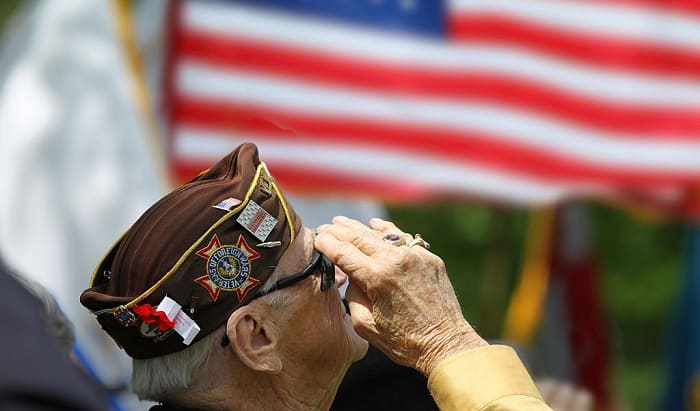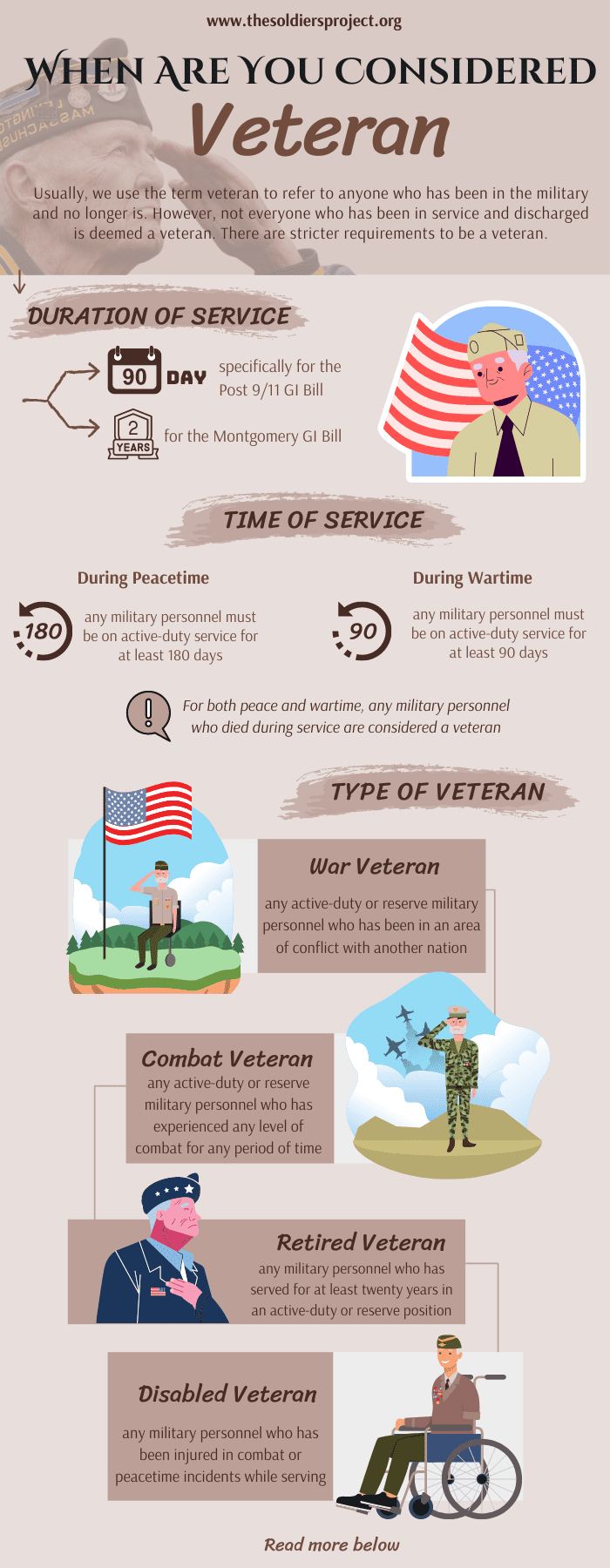Usually, we use the term veteran to refer to anyone who has been in the military and no longer is. In this way, a veteran is sometimes understood as retired military personnel.
However, the truth is, not everyone who has been in service and discharges is deemed a veteran. There are stricter requirements to be a veteran. Knowing the answer to “When are you considered a veteran?” helps a person determine his or her veteran status. This is incredibly important for many people, not only for the respected reputation but also for federal aid.
As a civilian, this may help you understand and appreciate veterans as well as celebrate Veterans Day more.
That being said, today’s article will provide the answer for your question along with another equally common question, “How long do you have to be in the military to be considered a veteran?”
Make sure you read until the very end to get all the essential information!
Table of Contents
Essential Information on the Veteran Status
According to Title 38 of the Code of Federal Regulations, a veteran is someone who has actively served in the armed forces for a certain period of time and was not dishonorably discharged. However, there are other factors that need to be taken into account.
1. Type of Service
Full-Time vs. Part-Time
The first area of consideration is whether you are full-time or part-time personnel. This depends on your specific job description. Most of the time, full-timers are active-duty service members, and those in the National Guard and Reserves are part-timers. To determine a person’s veteran status, particularly for identifying eligible benefits, it is crucial that the details of this are checked.
This is because even though members of the National Guard and Reserves go through the same basic military training and complete military job training, they may not meet the following requirements to be considered a veteran:
- They may not have been deployed under federal orders, which is needed to place a person on active-duty status. In particular, the deployment must satisfy the minimum requirements that are outlined for active-duty service members.
- They may not have been separated from service because of a disability related to any mandatory training. It must have been reported to the VA for a disabled status as well.
However, if you have served for 20 years or more in the National Guard or Reserve, you are given veteran status.
2. Duration of Service
There is a minimum service duration requirement when it comes to receiving benefits as a veteran. In detail, you must have been in active-duty service for
- 30 consecutive days before you are discharged for a disability connected to your service
- 90 days on or after the 10th of September, 2001 before you are discharged honorably
- 2 years before you are discharged honorably
The 90-day frame is specifically for the Post 9/11 GI Bill and the 2-year frame is for the Montgomery GI Bill).
If you were discharged during basic military training or another required training course because of a disability that was sustained while training, then you are still considered a veteran. However, this is only the case if you reported the injury to the VA and were recognized with a training or service-connected disability.
3. Time of Service
During Peacetime
To be considered a veteran, any military personnel must be on active-duty service for at least 180 days. The only exception is if the member sustained a service-related injury and was discharged under honorable conditions.
During Wartime
To be considered a veteran, any military personnel must be on active-duty service for at least 90 days. The exceptions are if the member sustained a service-related disability or received the Purple Heart and was discharged under honorable conditions.
For both peace and wartime, however, any military personnel who died during service are considered a veteran.
Other Categories
There are other categories of government service that may grant you veteran status. For example, if you were a scout in the Philippine Commonwealth Army and served between the 7th of December, 1941 and the 1st of January, 1947. Another instance is if you were a commissioned officer in the Environmental Science Services Administration, the Public Health Service, the National Oceanic & Atmospheric Administration, or the Coast & Geodetic Survey and possess a DD-214.
Unfortunately, this does not entail that a DD-214 equates to veteran status. Since a DD-214 is issued to any military personnel, including those in the National Guard and Reserves, upon completing the initial training for active duty, it is not enough to credit someone as a veteran.
Speaking of “categories”, the next section is about the different types of veterans. You may be eligible to receive different benefits depending on your type of veteran.
Type of Veteran
1. War Veteran
This refers to any active-duty or reserve military personnel who has been in an area of conflict with another nation or in surrounding water to support activity against an enemy.
2. Combat Veteran
This refers to any active-duty or reserve military personnel who has experienced any level of combat for any period of time as a result of an offensive, defensive, or friendly-fire action with an enemy in a foreign space.
3. Retired Veteran
This refers to any military personnel who has served for at least twenty years in an active-duty or reserve position. Among this type of veteran, there are medically retired ones that sustained injuries preventing them from continuing active duty. They are still considered veterans regardless of the number of years in service.
4. Disabled Veteran
This refers to any military personnel who has been injured in combat or peacetime incidents while serving and is, from then, permanently injured.
5. Veteran ID Card (VIC)
Every veteran should have a military veteran identification card. So, if you do not already have one, be sure to get one by following these two simple steps:
Prepared the identification documents required.
More specifically, you will need to have your social security number (SSN), a digital copy of your DD-214, DD-256, or DD-257. It should be in one of the following file formats: .jpeg, .png, or .pdf. In addition, you must have a non-expired passport, driver’s license, or state-issued identification card. Lastly, you should have a square digital photo of yourself that meets these requirements:
- Show a complete front of few of yourself from the shoulders up
- Your neck and face should be visible.
- So, no hat, head covering, or headphones, which may cast a shadow on your face.
- Your eyes should be open and your face should have a neutral expression.
- You should be against a white or plain-colored background.
Fill out the online application form.
Top Tip: If you have any problems with the application procedure or want to ask specific questions, you can send an email to [email protected].
Conclusion
Now, you know the complete answer to, “When are you considered a veteran of the military?” You do not have to ponder on your status anymore! On the flip side, if you are just starting to embark on your military commitment, you have a clearer picture of how to become a veteran.
Hopefully, you found this article helpful and interesting. Is there anything else you would like to share? If yes, make sure you leave a comment for us below. Also, do not forget to share this with other readers!

I am Everett Bledsoe, taking on the responsibility of content producer for The Soldiers Project. My purpose in this project is to give honest reviews on the gear utilized and tested over time. Of course, you cannot go wrong when checking out our package of information and guide, too, as they come from reliable sources and years of experience.




